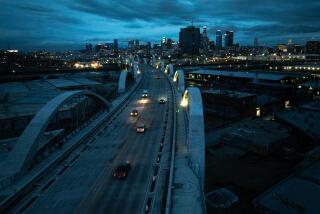Covered Bridge on Endangered Species List : History: Arson attacks, vandalism and neglect are reducing their numbers. The bridges are a reminder of a slower and simpler lifestyle.
- Share via
CONCORD, N.H. — On an early morning last May, someone went to the Corbin Covered Bridge in Newport, N.H., doused the timbers with a flammable liquid, struck a match and ended 158 years of history.
When firefighters arrived, burning timbers were dropping into the Sugar River. By morning, only ashes, charred debris and smoldering anger remained.
“I am shocked and angered, angered because it is history that can never be replaced,” said Alicia Dixon, a member of the Newport Historical Society. “I can’t imagine why anyone would do this.”
But she and others in Newport--a western New Hampshire town of 4,500 with a town seal that is a replica of the bridge--are not alone in their anger.
Covered bridges in Plymouth and Swanzey, N.H., and one in Barrow County, Ga., also were lost to arson this spring, and others in Ohio and Missouri have been damaged by arson attempts and random acts of vandalism.
Others fell to neglect: Two in Ohio have collapsed and bridges in Pennsylvania and California have been torn down and replaced with modern structures so far this year.
“This has been the worst year for covered bridges that I can remember,” said David Wright, president of the National Society for the Preservation of Covered Bridges.
The society, based in Westminster, Vt., has been tracking the nation’s covered bridges since the late 1940s, when country roads gave way to interstate highways and many of the picturesque structures were torn down to accommodate heavier traffic.
Wright estimates there once were 16,000 covered highway and railroad bridges in the country, nearly all built in the middle and late 19th Century. The most recent census, conducted in 1989, listed 871.
Pennsylvania has 221 covered bridges, the most of any state. Ohio is next with 140, followed by Vermont, 99; Indiana, 93, and New Hampshire, 48. In all, 30 states have at least one covered bridge.
To many, the bridges are a reminder of a slower and simpler lifestyle. Constructed mostly of native spruce, and now darkened by weather and age, covered bridges historically have been places where people would gather for political or revival meetings, to escape the sun on long summer afternoons or meet a sweetheart away from the prying eyes of family and friends.
Children often kicked out a board or two near the middle of a bridge to drop a fishing line.
“People just feel good when they look at a covered bridge; it’s as simple as that,” Wright said. “Steel and cement just don’t inspire the same reverence and the same awe as the old timber framing and joinery.”
Arnold Graton, 54, of Holderness, N.H., has been renovating and reconstructing covered bridges with his father, Milton, for 40 years. The pair have worked on bridges from California to New Hampshire, and are part of the few contractors in the nation who still build them “the old-fashioned way,” according to the younger Graton.
The elder Graton retired last year, leaving the business to his son, who hopes to rebuild the Corbin and Plymouth, N.H., bridges.
A covered bridge similar to the Corbin Bridge--96 feet long, 14 feet wide and with a vertical clearance of 12 feet, 7 inches--would cost about $750,000 to build, he said.
The spruce for the original bridges came from old-growth forests which no longer exist, he said. They now build with white pine and hemlock and join the wood with oak treenails (pronounced trunnels)--hand-hewn dowels as thick as a child’s wrist--that Graton makes during the winter.
Most of the old covered bridges were designed by a handful of largely self-taught engineers and are based on the simple truss, Wright said.
“Even though the bridge looks like a square box, it’s really a series of triangles. That’s where it gets its strength,” Graton said.
The familiar lattice work design is responsible for the durability of the bridges, which can last more than 150 years if properly maintained, Wright said.
He recently met with 30 state and local officials in New Hampshire to discuss ways of safeguarding covered bridges.
Among the methods discussed were fire-retardant wood treatments, heat and smoke detectors, video cameras and sprinkler systems. The group also called for legislation that would make burning historic bridges a more serious crime.
“But by far the best protection is to have a couple of people living next to the bridge keeping an eye on it,” Wright said.
Charlotte Haskell, 80, has lived next to the Jackson, N.H., covered bridge since 1943. She and her neighbor Flossie Gile, 88, are known as the bridge’s unofficial guardians.
“I look out every night before I go to bed,” Haskell said. “Sometimes around midnight there gets to be a little partying out there and I have a floodlight I wink on and off. That gets them moving.”
Gile said the pair also tries to make sure no illegal traffic crosses the bridge, built in 1876 and nicknamed the “Honeymoon Bridge” by a local inn around the turn of the century.
“We kind of watch the trucks and once in a while we see one that’s too heavy and we go out and tell them they shouldn’t be going over the bridge,” Gile said. “Then we tell them how to go around it. It’s only about two miles.
“After all, that bridge is kind of special to folks around here, and we’d hate awful to see anything happen to it.”
More to Read
Sign up for Essential California
The most important California stories and recommendations in your inbox every morning.
You may occasionally receive promotional content from the Los Angeles Times.










